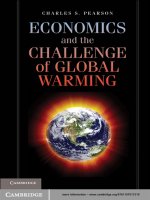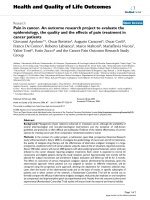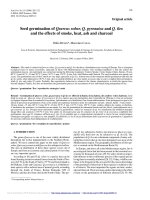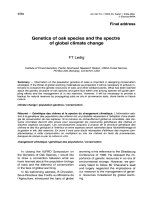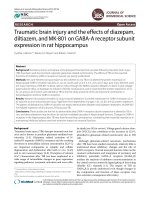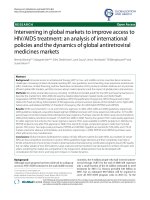Climate and the Effects of Global Climate Change
Bạn đang xem bản rút gọn của tài liệu. Xem và tải ngay bản đầy đủ của tài liệu tại đây (1.13 MB, 10 trang )
Climate and the Effects of Global Climate Change
Climate and the Effects of
Global Climate Change
Bởi:
OpenStaxCollege
All biomes are universally affected by global conditions, such as climate, that ultimately
shape each biome’s environment. Scientists who study climate have noted a series
of marked changes that have gradually become increasingly evident during the last
sixty years. Global climate change is the term used to describe altered global weather
patterns, including a worldwide increase in temperature, due largely to rising levels of
atmospheric carbon dioxide.
Climate and Weather
A common misconception about global climate change is that a specific weather event
occurring in a particular region (for example, a very cool week in June in central
Indiana) is evidence of global climate change. However, a cold week in June is a
weather-related event and not a climate-related one. These misconceptions often arise
because of confusion over the terms climate and weather.
Climate refers to the long-term, predictable atmospheric conditions of a specific area.
The climate of a biome is characterized by having consistent temperature and annual
rainfall ranges. Climate does not address the amount of rain that fell on one particular
day in a biome or the colder-than-average temperatures that occurred on one day. In
contrast, weather refers to the conditions of the atmosphere during a short period of time.
Weather forecasts are usually made for 48-hour cycles. Long-range weather forecasts
are available but can be unreliable.
To better understand the difference between climate and weather, imagine that you
are planning an outdoor event in northern Wisconsin. You would be thinking about
climate when you plan the event in the summer rather than the winter because you
have long-term knowledge that any given Saturday in the months of May to August
would be a better choice for an outdoor event in Wisconsin than any given Saturday in
January. However, you cannot determine the specific day that the event should be held
on because it is difficult to accurately predict the weather on a specific day. Climate can
be considered “average” weather.
1/10
Climate and the Effects of Global Climate Change
Global Climate Change
Climate change can be understood by approaching three areas of study:
• current and past global climate change
• causes of past and present-day global climate change
• ancient and current results of climate change
It is helpful to keep these three different aspects of climate change clearly separated
when consuming media reports about global climate change. It is common for reports
and discussions about global climate change to confuse the data showing that Earth’s
climate is changing with the factors that drive this climate change.
Evidence for Global Climate Change
Since scientists cannot go back in time to directly measure climatic variables, such
as average temperature and precipitation, they must instead indirectly measure
temperature. To do this, scientists rely on historical evidence of Earth’s past climate.
Antarctic ice cores are a key example of such evidence. These ice cores are samples of
polar ice obtained by means of drills that reach thousands of meters into ice sheets or
high mountain glaciers. Viewing the ice cores is like traveling backwards through time;
the deeper the sample, the earlier the time period. Trapped within the ice are bubbles
of air and other biological evidence that can reveal temperature and carbon dioxide
data. Antarctic ice cores have been collected and analyzed to indirectly estimate the
temperature of the Earth over the past 400,000 years ([link]a). The 0 °C on this graph
refers to the long-term average. Temperatures that are greater than 0 °C exceed Earth’s
long-term average temperature. Conversely, temperatures that are less than 0 °C are less
than Earth’s average temperature. This figure shows that there have been periodic cycles
of increasing and decreasing temperature.
Before the late 1800s, the Earth has been as much as 9 °C cooler and about 3 °C
warmer. Note that the graph in [link]b shows that the atmospheric concentration of
carbon dioxide has also risen and fallen in periodic cycles; note the relationship between
carbon dioxide concentration and temperature. [link]b shows that carbon dioxide levels
in the atmosphere have historically cycled between 180 and 300 parts per million (ppm)
by volume.
2/10
Climate and the Effects of Global Climate Change
Ice at the Russian Vostok station in East Antarctica was laid down over the course 420,000 years
and reached a depth of over 3,000 m. By measuring the amount of CO2 trapped in the ice,
scientists have determined past atmospheric CO2 concentrations. Temperatures relative to
modern day were determined from the amount of deuterium (an isotope of hydrogen) present.
[link]a does not show the last 2,000 years with enough detail to compare the changes
of Earth’s temperature during the last 400,000 years with the temperature change
that has occurred in the more recent past. Two significant temperature anomalies, or
irregularities, have occurred in the last 2000 years. These are the Medieval Climate
Anomaly (or the Medieval Warm Period) and the Little Ice Age. A third temperature
anomaly aligns with the Industrial Era. The Medieval Climate Anomaly occurred
between 900 and 1300 AD. During this time period, many climate scientists think that
slightly warmer weather conditions prevailed in many parts of the world; the higherthan-average temperature changes varied between 0.10 °C and 0.20 °C above the norm.
Although 0.10 °C does not seem large enough to produce any noticeable change, it did
free seas of ice. Because of this warming, the Vikings were able to colonize Greenland.
The Little Ice Age was a cold period that occurred between 1550 AD and 1850 AD.
During this time, a slight cooling of a little less than 1 °C was observed in North
America, Europe, and possibly other areas of the Earth. This 1 °C change in global
3/10
Climate and the Effects of Global Climate Change
temperature is a seemingly small deviation in temperature (as was observed during the
Medieval Climate Anomaly); however, it also resulted in noticeable changes. Historical
accounts reveal a time of exceptionally harsh winters with much snow and frost.
The Industrial Revolution, which began around 1750, was characterized by changes
in much of human society. Advances in agriculture increased the food supply, which
improved the standard of living for people in Europe and the United States. New
technologies were invented and provided jobs and cheaper goods. These new
technologies were powered using fossil fuels, especially coal. The Industrial Revolution
starting in the early nineteenth century ushered in the beginning of the Industrial Era.
When a fossil fuel is burned, carbon dioxide is released. With the beginning of the
Industrial Era, atmospheric carbon dioxide began to rise ([link]).
The atmospheric concentration of CO2 has risen steadily since the beginning of
industrialization.
Current and Past Drivers of Global Climate Change
Since it is not possible to go back in time to directly observe and measure climate,
scientists use indirect evidence to determine the drivers, or factors, that may be
responsible for climate change. The indirect evidence includes data collected using ice
cores, boreholes (a narrow shaft bored into the ground), tree rings, glacier lengths,
pollen remains, and ocean sediments. The data shows a correlation between the timing
of temperature changes and drivers of climate change: before the Industrial Era
(pre-1780), there were three drivers of climate change that were not related to human
activity or atmospheric gases. The first of these is the Milankovitch cycles. The
Milankovitch cycles describe the effects of slight changes in the Earth’s orbit on Earth’s
climate. The length of the Milankovitch cycles ranges between 19,000 and 100,000
years. In other words, one could expect to see some predictable changes in the Earth’s
climate associated with changes in the Earth’s orbit at a minimum of every 19,000 years.
4/10
Climate and the Effects of Global Climate Change
The variation in the sun’s intensity is the second natural factor responsible for climate
change. Solar intensity is the amount of solar power or energy the sun emits in a given
amount of time. There is a direct relationship between solar intensity and temperature.
As solar intensity increases (or decreases), the Earth’s temperature correspondingly
increases (or decreases). Changes in solar intensity have been proposed as one of several
possible explanations for the Little Ice Age.
Finally, volcanic eruptions are a third natural driver of climate change. Volcanic
eruptions can last a few days, but the solids and gases released during an eruption can
influence the climate over a period of a few years, causing short-term climate changes.
The gases and solids released by volcanic eruptions can include carbon dioxide, water
vapor, sulfur dioxide, hydrogen sulfide, hydrogen, and carbon monoxide. Generally,
volcanic eruptions cool the climate. This occurred in 1783 when volcanos in Iceland
erupted and caused the release of large volumes of sulfuric oxide. This led to hazeeffect cooling, a global phenomenon that occurs when dust, ash, or other suspended
particles block out sunlight and trigger lower global temperatures as a result; haze-effect
cooling usually extends for one or more years. In Europe and North America, hazeeffect cooling produced some of the lowest average winter temperatures on record in
1783 and 1784.
Greenhouse gases are probably the most significant drivers of the climate. When heat
energy from the sun strikes the Earth, gases known as greenhouse gases trap the heat
in the atmosphere, as do the glass panes of a greenhouse keep heat from escaping. The
greenhouse gases that affect Earth include carbon dioxide, methane, water vapor, nitrous
oxide, and ozone. Approximately half of the radiation from the sun passes through these
gases in the atmosphere and strikes the Earth. This radiation is converted into thermal
radiation on the Earth’s surface, and then a portion of that energy is re-radiated back
into the atmosphere. Greenhouse gases, however, reflect much of the thermal energy
back to the Earth’s surface. The more greenhouse gases there are in the atmosphere, the
more thermal energy is reflected back to the Earth’s surface. Greenhouse gases absorb
and emit radiation and are an important factor in the greenhouse effect: the warming of
Earth due to carbon dioxide and other greenhouse gases in the atmosphere.
Evidence supports the relationship between atmospheric concentrations of carbon
dioxide and temperature: as carbon dioxide rises, global temperature rises. Since 1950,
the concentration of atmospheric carbon dioxide has increased from about 280 ppm to
382 ppm in 2006. In 2011, the atmospheric carbon dioxide concentration was 392 ppm.
However, the planet would not be inhabitable by current life forms if water vapor did
not produce its drastic greenhouse warming effect.
Scientists look at patterns in data and try to explain differences or deviations from
these patterns. The atmospheric carbon dioxide data reveal a historical pattern of carbon
dioxide increasing and decreasing, cycling between a low of 180 ppm and a high of
5/10
Climate and the Effects of Global Climate Change
300 ppm. Scientists have concluded that it took around 50,000 years for the atmospheric
carbon dioxide level to increase from its low minimum concentration to its higher
maximum concentration. However, starting recently, atmospheric carbon dioxide
concentrations have increased beyond the historical maximum of 300 ppm. The current
increases in atmospheric carbon dioxide have happened very quickly—in a matter of
hundreds of years rather than thousands of years. What is the reason for this difference
in the rate of change and the amount of increase in carbon dioxide? A key factor
that must be recognized when comparing the historical data and the current data is
the presence of modern human society; no other driver of climate change has yielded
changes in atmospheric carbon dioxide levels at this rate or to this magnitude.
Human activity releases carbon dioxide and methane, two of the most important
greenhouse gases, into the atmosphere in several ways. The primary mechanism that
releases carbon dioxide is the burning of fossil fuels, such as gasoline, coal, and natural
gas ([link]). Deforestation, cement manufacture, animal agriculture, the clearing of
land, and the burning of forests are other human activities that release carbon dioxide.
Methane (CH4) is produced when bacteria break down organic matter under anaerobic
conditions. Anaerobic conditions can happen when organic matter is trapped underwater
(such as in rice paddies) or in the intestines of herbivores. Methane can also be released
from natural gas fields and the decomposition that occurs in landfills. Another source
of methane is the melting of clathrates. Clathrates are frozen chunks of ice and methane
found at the bottom of the ocean. When water warms, these chunks of ice melt and
methane is released. As the ocean’s water temperature increases, the rate at which
clathrates melt is increasing, releasing even more methane. This leads to increased levels
of methane in the atmosphere, which further accelerates the rate of global warming. This
is an example of the positive feedback loop that is leading to the rapid rate of increase
of global temperatures.
6/10
Climate and the Effects of Global Climate Change
The burning of fossil fuels in industry and by vehicles releases carbon dioxide and other
greenhouse gases into the atmosphere. (credit: “Pöllö”/Wikimedia Commons)
Documented Results of Climate Change: Past and Present
Scientists have geological evidence of the consequences of long-ago climate change.
Modern-day phenomena such as retreating glaciers and melting polar ice cause a
continual rise in sea level. Meanwhile, changes in climate can negatively affect
organisms.
Geological Climate Change
Global warming has been associated with at least one planet-wide extinction event
during the geological past. The Permian extinction event occurred about 251 million
years ago toward the end of the roughly 50-million-year-long geological time span
known as the Permian period. This geologic time period was one of the three warmest
periods in Earth’s geologic history. Scientists estimate that approximately 70 percent of
the terrestrial plant and animal species and 84 percent of marine species became extinct,
vanishing forever near the end of the Permian period. Organisms that had adapted to wet
and warm climatic conditions, such as annual rainfall of 300–400 cm (118–157 in) and
20 °C–30 °C (68 °F–86 °F) in the tropical wet forest, may not have been able to survive
the Permian climate change.
Link to Learning
7/10
Climate and the Effects of Global Climate Change
Watch this NASA video to discover the mixed effects of global warming on plant
growth. While scientists found that warmer temperatures in the 1980s and 1990s caused
an increase in plant productivity, this advantage has since been counteracted by more
frequent droughts.
Present Climate Change
A number of global events have occurred that may be attributed to climate change
during our lifetimes. Glacier National Park in Montana is undergoing the retreat of
many of its glaciers, a phenomenon known as glacier recession. In 1850, the area
contained approximately 150 glaciers. By 2010, however, the park contained only about
24 glaciers greater than 25 acres in size. One of these glaciers is the Grinnell Glacier
([link]) at Mount Gould. Between 1966 and 2005, the size of Grinnell Glacier shrank
by 40 percent. Similarly, the mass of the ice sheets in Greenland and the Antarctic is
decreasing: Greenland lost 150–250 km3 of ice per year between 2002 and 2006. In
addition, the size and thickness of the Arctic sea ice is decreasing.
The effect of global warming can be seen in the continuing retreat of Grinnel Glacier. The mean
annual temperature in the park has increased 1.33 °C since 1900. The loss of a glacier results in
the loss of summer meltwaters, sharply reducing seasonal water supplies and severely affecting
local ecosystems. (credit: modification of work by USGS)
This loss of ice is leading to increases in the global sea level. On average, the sea is
rising at a rate of 1.8 mm per year. However, between 1993 and 2010 the rate of sea level
increase ranged between 2.9 and 3.4 mm per year. A variety of factors affect the volume
of water in the ocean, including the temperature of the water (the density of water
8/10
Climate and the Effects of Global Climate Change
is related to its temperature) and the amount of water found in rivers, lakes, glaciers,
polar ice caps, and sea ice. As glaciers and polar ice caps melt, there is a significant
contribution of liquid water that was previously frozen.
In addition to some abiotic conditions changing in response to climate change, many
organisms are also being affected by the changes in temperature. Temperature and
precipitation play key roles in determining the geographic distribution and phenology
of plants and animals. (Phenology is the study of the effects of climatic conditions
on the timing of periodic lifecycle events, such as flowering in plants or migration in
birds.) Researchers have shown that 385 plant species in Great Britain are flowering 4.5
days sooner than was recorded earlier during the previous 40 years. In addition, insectpollinated species were more likely to flower earlier than wind-pollinated species. The
impact of changes in flowering date would be mitigated if the insect pollinators emerged
earlier. This mismatched timing of plants and pollinators could result in injurious
ecosystem effects because, for continued survival, insect-pollinated plants must flower
when their pollinators are present.
Section Summary
The Earth has gone through periodic cycles of increases and decreases in temperature.
During the past 2000 years, the Medieval Climate Anomaly was a warmer period, while
the Little Ice Age was unusually cool. Both of these irregularities can be explained by
natural causes of changes in climate, and, although the temperature changes were small,
they had significant effects. Natural drivers of climate change include Milankovitch
cycles, changes in solar activity, and volcanic eruptions. None of these factors, however,
leads to rapid increases in global temperature or sustained increases in carbon dioxide.
The burning of fossil fuels is an important source of greenhouse gases, which plays a
major role in the greenhouse effect. Long ago, global warming resulted in the Permian
extinction: a large-scale extinction event that is documented in the fossil record.
Currently, modern-day climate change is associated with the increased melting of
glaciers and polar ice sheets, resulting in a gradual increase in sea level. Plants and
animals can also be affected by global climate change when the timing of seasonal
events, such as flowering or pollination, is affected by global warming.
Review Questions
Which of the following is an example of a weather event?
1. The hurricane season lasts from June 1 through November 30.
2. The amount of atmospheric CO2 has steadily increased during the last century.
3. A windstorm blew down trees in the Boundary Waters Canoe Area in
Minnesota on July 4, 1999.
4. Deserts are generally dry ecosystems having very little rainfall.
9/10
Climate and the Effects of Global Climate Change
C
Which of the following natural forces is responsible for the release of carbon dioxide
and other atmospheric gases?
1.
2.
3.
4.
the Milankovitch cycles
volcanoes
solar intensity
burning of fossil fuels
B
Free Response
Compare and contrast how natural- and human-induced processes have influenced
global climate change.
Natural processes such as the Milankovitch cycles, variation in solar intensity, and
volcanic eruptions can cause periodic, intermittent changes in global climate. Human
activity, in the form of emissions from the burning of fossil fuels, has caused a
progressive rise in the levels of atmospheric carbon dioxide.
Predict possible consequences if carbon emissions from fossil fuels continue to rise.
If carbon emissions continue to rise, the global temperature will continue to rise; thus,
ocean waters will cause the rising of sea levels at the coastlines. Continued melting
of glaciers and reduced spring and summer meltwaters may cause summertime water
shortages. Changes in seasonal temperatures may alter lifecycles and interrupt breeding
patterns in many species of plants and animals.
10/10


